Punch Excision for Acne Scars
Acne is one of the most prevalent skin conditions around the world. There are a myriad of treatment options available when it comes to tackling acne breakouts. However, once the breakout is resolved, the resulting acne scars become another issue. Unfortunately, inflammation associated with acne can damage skin tissue, causing acne scarring. Oftentimes, treating acne scars can prove to be more difficult than treating acne lesions themselves. Some of the most stubborn acne scars are deep, narrow ice pick acne scars.
Effectively treating acne scars requires a professional approach. One of the key ways to remove ice pick scars is through a punch excision. These ice pick scars can be very difficult to remove. Through a combination of laser treatment, chemical peels, punch excision and TCA Cross, Dr. Green has managed to remove and treat this type of acne scarring. It often takes a combination approach to eliminate and improve acne scars.
Dr. Michele Green is a world renowned professional in cosmetic dermatology and has over 25 years of experience successfully treating acne and acne scars in her discreet, private, NYC office. Dr. Green takes a holistic approach to determine the best customized treatment options for improving the appearance of acne and acne scars. Dr. Green utilizes the most cutting edge treatments in her office and will tailor the best acne scar treatment plan to your skin type and type of acne scars.
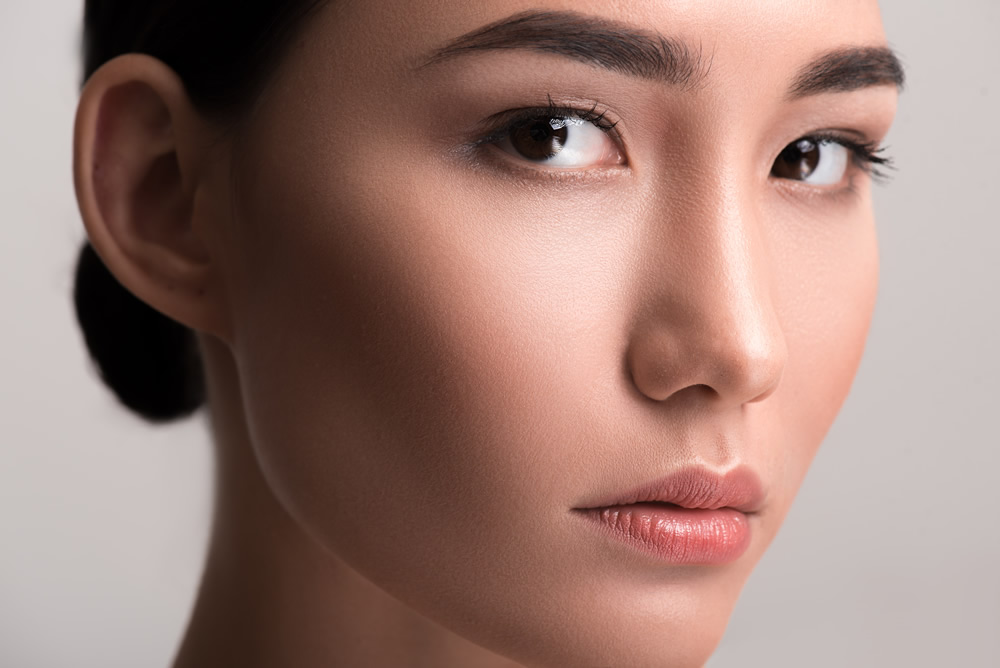
What is punch excision for acne scars?
Punch excision is a method for treating acne scarring in which a punch tool (regularly used for biopsy of skin cancer) is utilized to remove scar tissue. This scar revision treatment is a minimally invasive surgical procedure, ideal for deep ice pick scars. During the procedure, the punch tool is used to remove the acne scar. After removing the scar, the wound left behind is closed with fine sutures.
Punch grafting is a variation of punch excision where a skin graft is required to patch an area of biopsy. This may be required for larger or deeper acne scars being treated with punch excision. The skin graft is typically taken from behind the ear or the ear lobe, and is held in place with either sutures or steri-strips. This plastic surgical procedure is reserved for some of the deepest and broadest acne scars.
Punch elevation is similar to punch excision and is often used for treatment of wider ice pick or boxcar scars. In this method, the punch tool is used to remove the base of the acne scar while leaving the surrounding skin tissue intact. This effectively raises the scar, diminishing the overall appearance of the scar by evening out the skin texture.
Punch excision can not be used to treat raised acne scars, like keloids, or hyperpigmented acne scars. Additionally, punch excision is unable to treat any hyperpigmentation associated with an acne scar. Complementary treatments, such as laser resurfacing, chemical peels, or TCA Cross, can be used to further diminish evidence of acne scars.
Does punch excision leave a scar?
Punch excision for acne scar revision generally does leave behind slight scarring of its own, though the scars are smaller, softer, and less noticeable than the original atrophic scars. The scar left behind after punch excision will most often resemble a small line as opposed to a depression.
Does punch excision hurt?
Prior to performing a punch excision, the treated area is injected with lidocaine. This numbs the treatment area to minimize discomfort associated with the procedure. You can generally expect that the most uncomfortable step in the process of punch excision is the simple lidocaine injection used as a local anesthetic before the procedure. Typically, patients do not experience side effects, though there may be mild soreness at the site of treatment post-procedure for a few days.
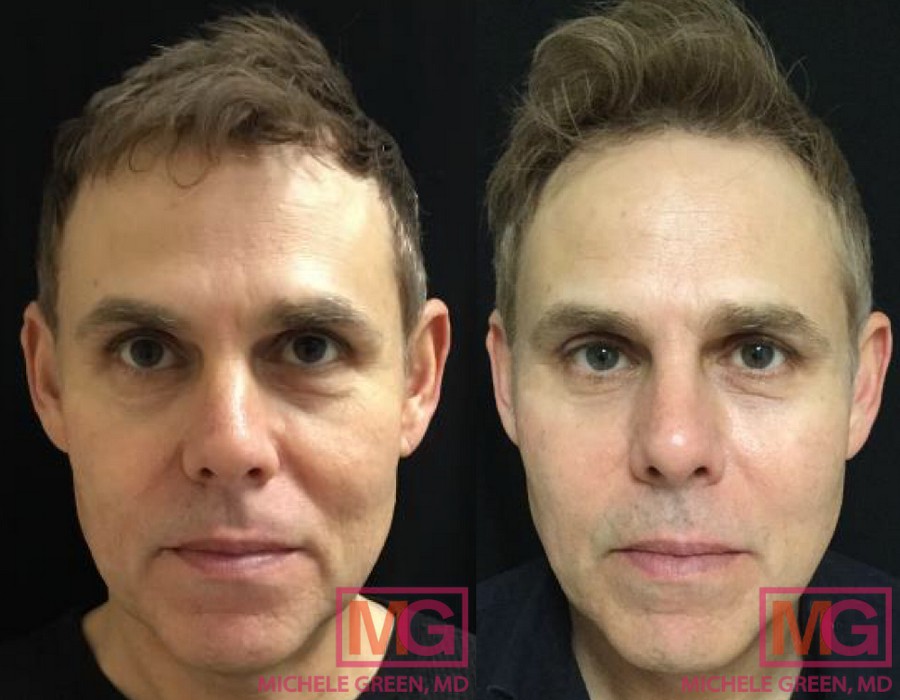
eMatrix for Acne Scars: 3 months before and after
How much is punch excision?
Estimating the price of acne scar removal can be difficult since cost is dependent on several factors. The amount of scarring of the patient to be treated needs to be taken into consideration when estimating cost. A patient with more severe scarring may require more punch excisions than a patient with only mild or moderate scarring. Often, to achieve the best results, a combination of treatments is required. If your punch excision treatment is combined with other methods of acne scar treatment, price can fluctuate. The geographic location of the dermatology office you visit and the experience level of the provider performing the procedure can also influence the total cost of your treatment.
TCA Cross for Acne Scars
TCA is an abbreviation for trichloroacetic acid, the chemical acid used by Dr. Green for chemical peels and TCA Cross. “Cross” is an acronym for the chemical reconstruction of skin scars method, a treatment for acne scars that entails the application of trichloroacetic acid directly into atrophic scars, leaving the surrounding skin untouched. The placement of the acid, which is generally 70-100% concentrated, into the scar stimulates collagen regeneration in that location. Through the healing process, new collagen is formed. This treatment is ideal for use with ice pick or boxcar scars, and the result is an overall more even skin texture and rejuvenated appearance.
Treating Acne Scars with Multiple Modalities
Determining the most effective treatment for your acne scars should be done in a dermatology office with the guidance of a board-certified skin expert, like Dr. Michele Green. Due to the complexity and variety of acne scars, multiple modalities of treatment are often required to optimize results. A combination approach is often taken for acne scars, since most patients have a combination of scars. Dr. Green may combine dermal fillers, such as Restylane and Sculptra, with lasers such as Fraxel or eMatrix, to restore the skin texture and improve your acne scars.
For deep, narrow ice pick scars, punch excision removes the scar tissue itself, while leaving behind a thin, often linear scar. For this reason, atrophic scars (ice pick acne scars and boxcar scars) often require a combination of treatments, potentially including laser treatments, chemical peels, or dermal fillers to maximize collagen production for skin resurfacing.
How to Treat Ice Pick Scars
Ice pick scars are deep and narrow, often resembling enlarged skin pores in appearance. The term “ice pick” scar is used because the skin appears as if it has been pierced by a sharp tool, or an ice pick. Individuals with cystic acne are typically more prone to developing ice pick scars since the inflammation associated with cystic acne breakouts can lead to damaged skin tissue.
In order to best treat ice pick scars, a combination of procedures is often required. Punch excision and laser skin resurfacing treatments are two methods that are frequently suggested for treating these acne scars, though there are numerous treatment options available. An acne scar treatment plan should be customized for each patient, taking into consideration skin type and type of scarring. During your consultation with Dr. Green, she will determine the best laser treatments, dermal fillers, and skin care for you to have the best cosmetic results.
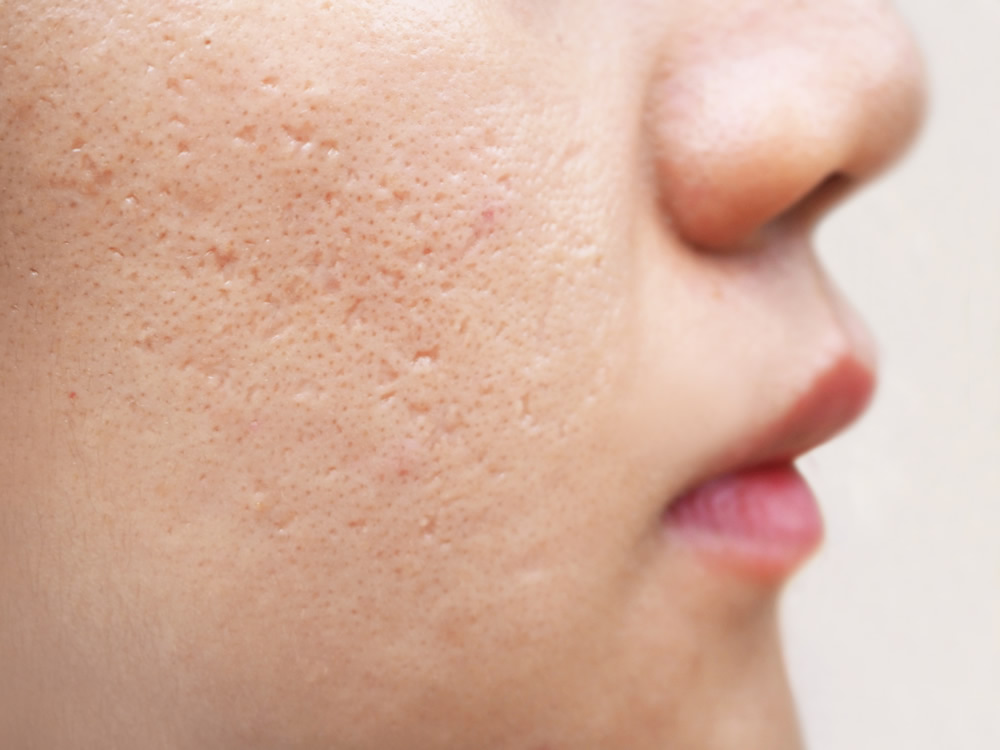
Subcision for Acne Scars
Subcision is a minimally invasive surgical technique for scar revision that ultimately encourages collagen production in the skin. During this procedure, a needle is used to puncture the skin and break up fibrous scar tissue. Breaking apart scar tissue stimulates new collagen production in the skin, resulting in a smoother, more even skin texture.
Dr. Green often combines subcision treatments with dermal filler to achieve ideal results. The benefit of using a dermal filler in tandem with subcision for certain types of acne scars is that the hyaluronic acid of the dermal filler provides immediate improvement of the acne scars, while the subcision stimulates production of new collagen at the treatment site. Dr. Green’s unique approach of combining subcision at the same time as the injection of the dermal filler, is what provides immediate and long term improvement of acne scars.
Laser Resurfacing for Acne Scars
Fraxel laser treatment is a non-ablative, non-invasive treatment for acne scars. This innovative approach uses fractional laser technology to create micro-injuries in the dermis of the skin, leaving the epidermis intact and surrounding skin undamaged. Through the natural healing process, new collagen is formed. The result is an overall smoother skin texture and reduced appearance of acne scars.
CO2 laser resurfacing treatment is generally used for more severe cases of acne scarring. This is an ablative procedure that effectively removes the top layer of skin, while heating the underlying layer of skin, promoting collagen production. The CO2 laser is a more aggressive treatment than Fraxel, requiring more downtime, and will also result in a smoother skin tone and texture.
Best Treatment Options for Removing Acne Scars
The VBeam laser is a non-ablative treatment that is ideal for correcting skin redness and treating red and hypertrophic acne scars. The Vbeam operates at a wavelength that specifically targets skin cells that store the red pigment. These skin cells absorb the heat energy from the laser while leaving surrounding skin unharmed. This laser treatment can be utilized to treat the appearance of acne lesions, broken blood vessels, rosacea, and acne scars which are red. There is no downtime for this treatment and a built into the Dynamic Cooling Device™ cools the skin before the laser is emitted, making the procedure comfortable with no recovery time.
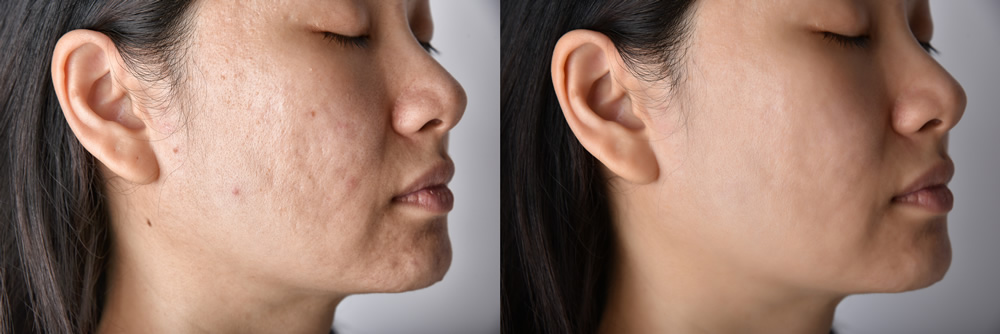
Microneedling is a technique that employs tiny surgical needles to create micro-injuries in the skin. This collagen-inducing process helps promote skin cell turnover and the result is smooth, clear, beautiful skin that’s overall, more even in tone and texture. To enhance the benefits of microneedling, the procedure can be performed with Platelet Rich Plasma (PRP). For Microneedling with PRP, a sample of the patient’s blood is collected and spun in a centrifuge to create a unique plasma that contains a high concentration of platelets. PRP utilizes the body’s own natural growth factors to further elevate the restoration and revitalization of the skin, resulting in the diminishment of acne scars.
The eMatrix Sublative Rejuvenation uses fractionated bi-polar frequency to penetrate beneath the skin’s surface to maximize the amount of collagen and elastin produced. Stimulating the skin’s production of collagen and elastin improves textural irregularities and treats acne scars. The eMatrix laser can treat textural issues on skin of any tone and type, making it a powerful tool to combat against stubborn acne scars. Using this laser treatment helps patients with acne scars achieve smoother, brighter, tighter, more beautiful, younger-looking skin. Since sublative rejuvenation has only 48 hours of downtime, this laser treatment can be scheduled with ease.
Microdermabrasion is a non-chemical and a non-invasive procedure improves skin tone and texture by removing the upper layer of dead and damaged skin cells. Microdermabrasion also promotes the production of new skin cells, which have higher levels of collagen, resulting in a reduced appearance of mild acne scars. This procedure should not be confused with dermabrasion, which requires anesthesia and a significant amount of downtime.
Vivace Microneedling with RF can help rejuvenate and restore skin if you’re struggling with irregular texture after experiencing an acne breakout, revealing an even, smooth, beautiful complexion. The radiofrequency technology delivers heat to the dermis while the microneedles penetrate the epidermis, both creating micro-injuries in the skin. This unique and revolutionary technology combines radiofrequency energy and microneedling in order to stimulate the natural wound healing process of the skin, encouraging maximum collagen and elastin production, providing smoother, tighter, fresher looking skin.
Dermabrasion is a skin resurfacing procedure used in dermatology and plastic surgery to treat more severe acne scars. A rapidly rotating device is used to sand the outer layers of skin. This exfoliative treatment can be used to treat atrophic scars and facial wrinkles.
There are countless treatment methods that are utilized in order to diminish the appearance of acne scars. In order to determine which combination of treatments and skincare are best suited to treating your scars, schedule an appointment with a board-certified dermatologist, like Dr. Michele Green.
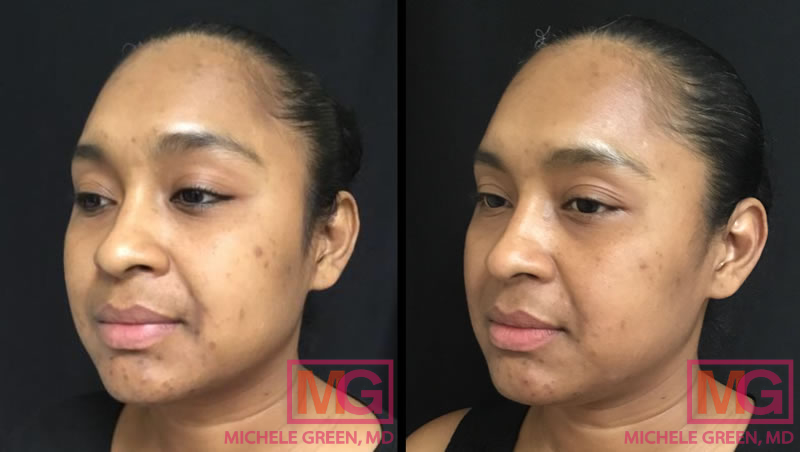
Acne scar and hyperpigmentation treatment: 1 month before and after
Skin Care for Acne Scars
We can boost the results of in-office treatments for acne scars with the skincare products we use at home to help achieve and maintain a smooth, beautiful complexion. Dr. Michele Green will help design the best skin care products for your to rejuvenate your skin and improve your complexion. With her MGSKINLABs, unique skin care products, Dr. Green will help create both treatment options for you to improve your skin tone, texture, as well as hyperpigmentation, fine lines, or acne scars.
Incorporating a topical vitamin C serum into your skincare regime can help increase the amount of natural collagen production in the skin and diminish hyperpigmentation to reveal a more even overall skin tone and texture. Vitamin C is a powerful antioxidant that boosts collagen production and promotes skin cell turnover, helping to create an overall smooth, even, youthful, and beautiful complexion. The restorative properties of L-ascorbic acid (the active version of Vitamin C) contribute to the acceleration of collagen and elastin production in the skin. Dr. Michele Green has formulated a serum with a high concentration of Vitamin C that effectively revitalizes the skin and helps repair damage done by the sun. Using the Vita-C serum morning and night after cleansing will result in skin that looks and feels more radiant, youthful, and healthy.
Retinoids are a derived from vitamin A and can help minimize the appearance of acne scars by regenerating the skin cells and improving overall skin texture. In the dermis (the middle layer of skin), retinoids contribute to stimulating collagen and elastin production. Retinoids also exfoliate the epidermis (the top layer of skin), helping to keep pimples from forming and maintain a clear complexion. Dr. Green has developed a formula that will optimize collagen production in the skin overnight. The Essential Antioxidant Infusion delivers a pure concentration of vitamins A, C, E and other nutrients to exfoliate, renew and replenish skin. You can expect to achieve a healthier, more youthful appearance that comes with diminished visible lines and wrinkles, repaired skin elasticity and improved skin texture.
Salicylic acid helps to exfoliate the skin, increasing skin cell turnover and helping to even out the tone and texture of skin. Including skincare products that contain salicylic acid in your skincare regimen can help control acne breakouts and diminish the appearance of acne scars. When you consult with Dr. Green, she will renew all of your current skin care products and help guide you to the best ingredients and products to use to rejuvenate and improve your skin tone and texture.
How do I get started with acne scar treatment today?
If you are frustrated by the appearance of acne scars, or struggling to manage active acne breakouts, Dr. Michele Green. Dr. Green has over 25 years of experience successfully customizing treatment plans for thousands of patients with acne and acne scars. Dr. Green is consistently voted as one of the best dermatologists in New York by Castle Connolly, New York Magazine, Super Doctors, and the New York Times. To schedule a consultation with Dr. Green, please contact our NYC based office or call 212-535-3088 to learn more about which acne scar treatment is right for you.
 212-535-3088
212-535-3088